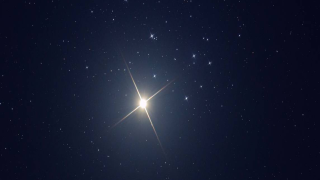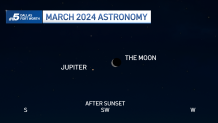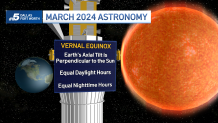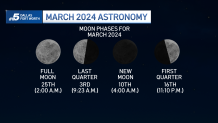
BRIGHT MORNING STAR, VENUS
Venus is on display for the entire month of March, in place as a brilliant morning star sitting low in the southeast sky before sunrise.

On March 21st, Venus will be joined by Saturn (very low in the eastern sky). On March 29th, Saturn will be halfway between low and bright Venus and the higher and dimmer Mars.
Get DFW local news, weather forecasts and entertainment stories to your inbox. Sign up for NBC DFW newsletters.
Venus's distance from the Earth varies from 24 million miles to 162 million miles.
Saturn's distance varies from the Earth. When the two are closest, they lie approximately 746 million miles apart, or eight times the distance between the Earth and the Sun.
At their most distant, when they lie on opposite sides of the Sun from one another, they are just over a billion miles apart, or 11 times the distance between the Earth and the Sun.
Weather Connection
Connecting you with your forecast and all the things that make North Texas weather unique.
Mars averages a distance from the Earth of 140 million miles. The closest recorded distance to Mars from Earth was recorded in August 2003 when the two were 34.8 million miles apart. According to NASA, the two will not be that close again until the year 2237.
THE CHANGING OF THE CLOCK
On March 10th, Daylight Saving Time begins. Time to spring forward!
This will happen on Sunday at 2 a.m., you may wish to ensure all clocks are set forward Saturday evening, March 9th.

JUPITER MEETS THE MOON
On March 13th, visible in the southwestern sky just after sunset will be the gorgeous sight of a crescent moon beside bright planet Jupiter.

Jupiter's distance from the Earth varies from 336 million miles to 600 million miles.
THE SPRING EQUINOX
On March 19th at 10:06 p.m. CDT., the season officially changes from winter to spring with the arrival of the spring (vernal) equinox.

The spring (vernal) equinox marks the exact moment that the Sun is above the equator somewhere on Earth, meaning night and day are the same lengths across the globe. The Sun will rise perfectly due east and set due west.
HELLO, MERCURY
Mercury will be making an appearance in the North Texas sky by March 24th. Catch Mercury in the west after sunset. Look for the brightest “star” near the horizon. It’ll be visible for a few weeks before fading and disappearing in April. Telescopes offer a better look at the planet closest to the Sun.

Mercury's distance from the Earth varies from 48 million miles to 137 million miles.
A MICRO FULL WORM MOON
On March 25th, North Texas will witness a micro full worm moon. First, what is a micromoon? A micromoon occurs when a full moon occurs at apogee - that is the furthest the moon is away from Earth.

A micro full moon’s angular size is 12.5%–14.1% smaller than a super full moon and 5.9%–6.9% smaller than an average full moon. It is also 30% dimmer.
Full moons and new moons cause differences between high and low tides. During these moon phases, the gravitational forces of the moon and the Sun combine to pull the ocean’s water in the same direction. These tides are known as spring tides or king tides. Micromoons can lead to around 2 inches smaller variation than regular spring tides, called apogean spring tides.
Secondly, the March full moon is known as the Worm Moon.
The name, Worm Moon, refers to a different sort of “worm”—beetle larvae—which begin to emerge from the thawing bark of trees and other winter hideouts.
MONTHLY MOON PHASES
Also, check out other phases of the moon this month.

On March 10th at 1:04 a.m. CST., the moon will be at perigee, it is closest to the Earth for this orbit at 221,764 miles. On March 23rd at 10:45 a.m. CDT., the moon will be at apogee, its farthest from the Earth for this orbit at 252,460 miles.
WHEN DOES THE INTERNATIONAL SPACE STATION FLY OVER NORTH TEXAS?
The International Space Station will make flybys across the North Texas sky this month. The ISS appears as a fast-moving star across the night sky.

The International Space Station rotates around the Earth at a speed of 17,500 mph. The ISS rotates about its center of mass at a rate of about 4 degrees per minute so that it will complete a full rotation once per orbit. This allows it to keep its belly towards the Earth. One revolution around the planet takes about 90 minutes (16 per day).
Also, the International Space Station lies at an altitude of 250 miles above the Earth. By the way, that is 1.32 million feet. Most commercial airplanes fly between 33,000 to 42,000 feet.
Please enjoy these events happening in the night sky this month. Until then...Texans, keep looking up!



